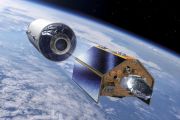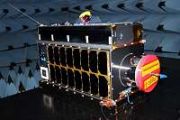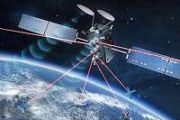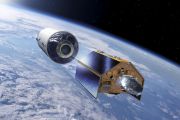
Copernical Team
Researchers capture first images of a radio 'ring of fire' solar eclipse
 Researchers at New Jersey Institute of Technology's Center for Solar-Terrestrial Research (NJIT-CSTR) have captured the Oct. 14 solar eclipse in a way never seen before - recording the first radio images of an annular eclipse's famous "ring of fire" effect.
The eclipse was partially visible to much of the continental U.S. for several hours that Saturday, though the full "ring of fire" effe
Researchers at New Jersey Institute of Technology's Center for Solar-Terrestrial Research (NJIT-CSTR) have captured the Oct. 14 solar eclipse in a way never seen before - recording the first radio images of an annular eclipse's famous "ring of fire" effect.
The eclipse was partially visible to much of the continental U.S. for several hours that Saturday, though the full "ring of fire" effe The Moon is 40 million years older than previously thought
 By analyzing tiny lunar crystals gathered by Apollo 17 astronauts in 1972, researchers recalculated the age of the Earth's Moon. Although previous assessments estimated the Moon as 4.425 billion years old, the new study discovered it is actually 4.46 billion years old - 40 million years older than previously thought.
Led by researchers at the Field Museum and the University of Glasgow, the
By analyzing tiny lunar crystals gathered by Apollo 17 astronauts in 1972, researchers recalculated the age of the Earth's Moon. Although previous assessments estimated the Moon as 4.425 billion years old, the new study discovered it is actually 4.46 billion years old - 40 million years older than previously thought.
Led by researchers at the Field Museum and the University of Glasgow, the Mouse mummies point to mammalian life in "Mars-like" Andes
 The dry, wind-swept summits of volcanoes in the Puna de Atacama of Chile and Argentina are the closest thing on Earth to the surface of Mars due to their thin atmosphere and freezing temperatures. At their extreme elevations of more than 6,000 meters above sea level, experts had concluded that mammalian life simply wasn't possible. But researchers reporting October 23 in the journal Current Biol
The dry, wind-swept summits of volcanoes in the Puna de Atacama of Chile and Argentina are the closest thing on Earth to the surface of Mars due to their thin atmosphere and freezing temperatures. At their extreme elevations of more than 6,000 meters above sea level, experts had concluded that mammalian life simply wasn't possible. But researchers reporting October 23 in the journal Current Biol UArizona researchers probe how a piece of the moon became a near-Earth asteroid
 In 2021, a team of University of Arizona astronomers suggested that a recently discovered near-Earth asteroid, Kamo`oalewa, could be a chunk of the moon. Two years after the striking discovery, another UArizona research group has found that a rare pathway could have enabled this to happen.
So far, only distant asteroids from beyond the orbit of Mars have been considered a source of near-Ea
In 2021, a team of University of Arizona astronomers suggested that a recently discovered near-Earth asteroid, Kamo`oalewa, could be a chunk of the moon. Two years after the striking discovery, another UArizona research group has found that a rare pathway could have enabled this to happen.
So far, only distant asteroids from beyond the orbit of Mars have been considered a source of near-Ea Texas A and M joins multimillion-dollar moon orbit tracking project
 Texas A and M University is joining a multi-university team on a major research project to track objects orbiting the moon. The Air Force Research Laboratory is awarding up to $5 million over five years for the Space University Research Initiative (SURI).
"The SURI is an outstanding initiative to train our next-generation workforce. We look forward to carrying out creative research aimed a
Texas A and M University is joining a multi-university team on a major research project to track objects orbiting the moon. The Air Force Research Laboratory is awarding up to $5 million over five years for the Space University Research Initiative (SURI).
"The SURI is an outstanding initiative to train our next-generation workforce. We look forward to carrying out creative research aimed a CRS-29 mission flies research to the Space Station
 The 29th SpaceX commercial resupply services (CRS) mission for NASA carries scientific experiments and technology demonstrations, including studies of enhanced optical communications and measurement of atmospheric waves. The uncrewed SpaceX Dragon spacecraft is scheduled to launch to the International Space Station from the agency's Kennedy Space Center in Florida no earlier than Nov. 5.
The 29th SpaceX commercial resupply services (CRS) mission for NASA carries scientific experiments and technology demonstrations, including studies of enhanced optical communications and measurement of atmospheric waves. The uncrewed SpaceX Dragon spacecraft is scheduled to launch to the International Space Station from the agency's Kennedy Space Center in Florida no earlier than Nov. 5. Dragonfly tunnel visions
 With its dense atmosphere and low gravity, Saturn's moon Titan is a great place to fly.
But well before NASA's Dragonfly rotorcraft lander soars through Titan's skies, researchers on Earth - led by the Johns Hopkins Applied Physics Laboratory (APL) in Laurel, Maryland - are making sure their designs and models for the nuclear-powered, car-sized drone will work in a truly unique environment
With its dense atmosphere and low gravity, Saturn's moon Titan is a great place to fly.
But well before NASA's Dragonfly rotorcraft lander soars through Titan's skies, researchers on Earth - led by the Johns Hopkins Applied Physics Laboratory (APL) in Laurel, Maryland - are making sure their designs and models for the nuclear-powered, car-sized drone will work in a truly unique environment Astronomers carry out largest ever cosmological computer simulation
 An international team of astronomers has carried out what is believed to be the largest ever cosmological computer simulation, tracking not only dark but also ordinary matter (such as planets, stars and galaxies), giving us a glimpse into how our Universe may have evolved. The FLAMINGO simulations calculate the evolution of all components of the universe - ordinary matter, dark matter, and dark
An international team of astronomers has carried out what is believed to be the largest ever cosmological computer simulation, tracking not only dark but also ordinary matter (such as planets, stars and galaxies), giving us a glimpse into how our Universe may have evolved. The FLAMINGO simulations calculate the evolution of all components of the universe - ordinary matter, dark matter, and dark Exoplanet-informed research helps search for radio technosignatures
 In a new study published in the Astronomical Journal, researchers used the known population of exoplanets and extrapolated to the much larger, unknown population of exoplanets to set better thresholds for planetary effects on signals from ETIs (extraterrestrial intelligences). The prior recommendation for the threshold "drift rate" contribution, caused by a planet's motion around its host star,
In a new study published in the Astronomical Journal, researchers used the known population of exoplanets and extrapolated to the much larger, unknown population of exoplanets to set better thresholds for planetary effects on signals from ETIs (extraterrestrial intelligences). The prior recommendation for the threshold "drift rate" contribution, caused by a planet's motion around its host star, A Russian satellite has shifted within 60 km of another spacecraft
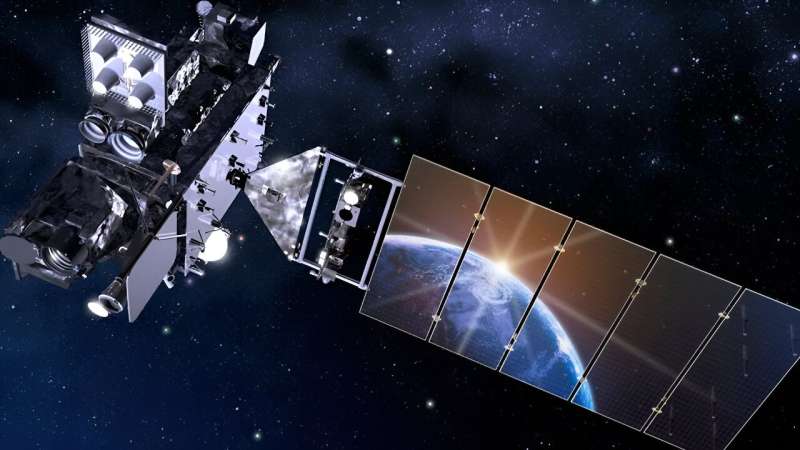
When it comes to saber-rattling, few countries employ it as much as Russia does. During their ongoing invasion and occupation of Ukraine, the country's leadership has repeatedly threatened to use atomic weapons. But the threats don't stop there.
A private company called Slingshot Aerospace says Russia has maneuvered one of their Luch satellites uncomfortably close to Western spacecraft in GEO (geostationary orbit.)
And it's not the first time.
The satellite in question is named Luch (Olymp) 2 and its Norad ID is 55841. Russia launched it in March of 2023, and it's a successor to Luch (Olymp) Norad ID 40258. The naming conventions are a little confusing, but Luch 1 was a well-known interloper.









